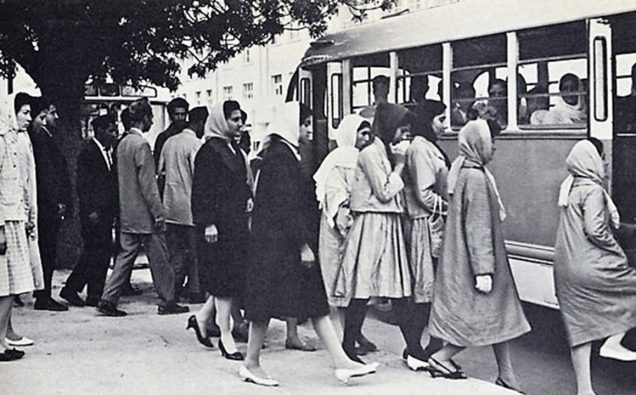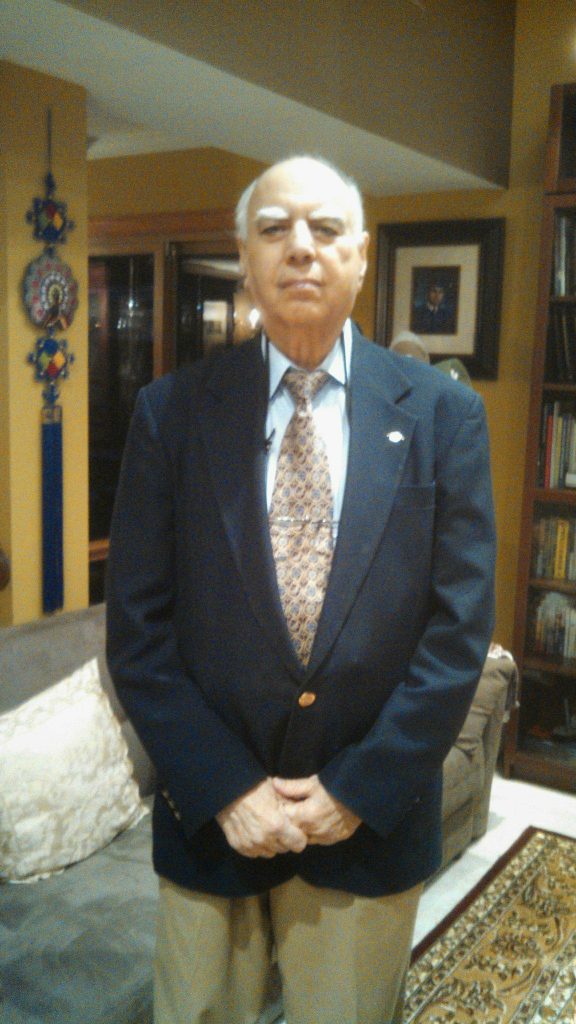
Kabul in 1950s or 1960s with modern transport system Photo: Public Domain/Wikipedia
Afghanistan and Pakistan have been part of American news cycle for more than 16 years now since the U.S. invaded the country in 2001 after the September 11th terrorist attacks. Based on my long experience in the region, here is I have found the two countries and where we stand in terms of counterterrorism goals and issues.
First Afghanistan, It is a landlocked country bordering Pakistan, Iran, Tajikistan, Uzbekistan, Kyrgyzstan (formerly part of Soviet Union), and China. It has been the crossroads of civilizations, and a place of intermingling of cultures and traditions from antiquity. Invading armies ranging from Aryans, Alexander the Great to Muslims Conquerors have left an inedible mark on Afghanistan’s rich history.
Afghanistan has also been a significant stop on the trade land route between East and West, and on the famous silk route. The famous travelers, Marco Polo who traveled from Venice to China, and Ibn-e-Batuta, the renowned Arab traveler, who traveled from North Africa to China, left their footprints in this land.
During King Zahir Shah’s regime, Afghanistan was a mosaic of Eastern and Western cultures. You could see women in the bazaar clad in old-fashioned burqas (nicknamed shuttle-cock) and dressed in Western attire, with latest fashions in dresses and hairstyles.
I was known to the entire diplomatic corps by virtue of being in the wine business. In addition, there was a large contingent of United Nations working in Afghanistan. When the cold war was at its highest, Afghanistan was in the Russian camp. However, Afghanistan demonstrated superb diplomacy by wooing America to make a super highway from the Iranian Border, Heart to the Pakistani border at Torkhum via Kabul, while the Russians built the highway from Kabul to the Oxus River via the Salang Pass. Russia always wanted to get to the warm waters of the Persian Gulf. Every country had their best diplomats posted in Kabul.
I also got to know the entire USAID expatriate staff right from the Director down, and became a member of the Duplicate Bridge Club. I still have a coupon book as a souvenir, which we would use to buy food and drinks at the club. It was a welcome place to immerse back into Americana after having spent 10 years living and working with the Americans in Pakistan.
An avid traveler, I traveled extensively throughout Afghanistan. Its several varieties of grapes and melons are world famous and were the favorite of Babur, founder of the Mogul dynasty of India. He wrote with relish in his travelogue, ‘Tuzk-i-Baburi’. Besides grapes and melons, Afghanistan is known for its wild pistachio groves, delicious apricots and pomegranates.
There are a number of excellent travel books: After you Marco Polo by Jean Bovary Shore”, “Kingdom of Kabul” by Mountsturart Elphinston, and “Mission to Bokhara” by Sir Alexander Burns.
Also, there are a couple of Hollywood movies on Afghanistan: “Caravan” based on a novel by James Michener, played by Anthony Quinn posing as Chief of a Koochi (nomadic) tribe that traverse Afghanistan from South to North during change of the seasons, to find grazing ground for their cattle and sheep. It is an epic love story – an American woman doing engineering research in South Western Afghanistan, traveling with the Koochi caravan, and falling in love with the Chief (Anthony Quinn).

Bagh e Babur Garden, Kabul Photo: Ninaras/Wikimedia Commons
Another great movie is “Horsemen” played by Omar Sharif, an epic Afghan love story with fantastic scenes of the Afghan national pastime “Buzkashi” – to snatch a carcass of a calf from the ground on a galloping horse and take it to the opposite end with dozens by horses converging at one place, and riders whipping each other mercilessly to take hold of the carcass, displaying horsemanship at it best. Buskashi is an offshoot of the old Mongolian sport, a predecessor of modern horse polo. Life was good in Kabul, but fate had other plans.
One day while sitting at the PIA office, next to Kabul Hotel, I saw a group of Kabul University students demonstrating outside. I made a comment, that whenever university students demonstrate, it always leads to trouble and that a coup could take place in Afghanistan in 3-5 years. My friend said no way, as the King was installed on the Kabul thrown for the last 38 years; was a Pakhtoon, and that his son-in-law was the Commander-in-Chief of the Afghan Army. I personally knew some of the members of the royal family except the king himself.
Within a short time (1973) in one moonlit night in the summer, I heard gunfire. Our house was located next to General Khan Mohammad, Commander of the Royal Palace Guards. There was a paramilitary battalion on a hillock not far from our house. I saw tracer bullets going by our bedroom windows and I woke up my wife. Our children were in the next bedroom with the Nanny, and also, we had guests from Pakistan. I woke every one up and moved downstairs. We had no basement but had servant quarters at the back.
In the morning I woke up as usual, had breakfast and our servant opened the garage. When I backed out, I saw about 6-7 dead bodies lying on the street between our and the general’s house. Still it did not register and I proceeded to work. When I came to the first intersection, not too far from our place, I saw a military tank, and immediately turned on my car radio on and heard an announcement from Sardar Daud Khan, the first cousin of King Zahir Shah, announcing that the king had been overthrown in a coup d’état. Midnight was the zero hour. Sardar Daud also said that they had no dispute with any nation in the world, except Pakistan (over the Pashtoonistan problem).
When I came home for lunch, I saw an Afghan Army soldier with a submachine gun pointed at our house. He saluted me and said apologetically that he had been ordered to do so, but that my family should not have any fear. My wife sent food for him. In any case I evacuated my family to Pakistan, vacated the big mansion and moved into a small apartment.
The Soviet Invasion – President Roland Reagan provided massive aid and military equipment to the Mujahedeen (Freedom Fighters) to fight the Russian. Upon exit of the Russian army, The Mujahidin turned into various factions of Taliban, fighting against the UN army headed by the United States. During the early days of this program, I was invited to a luncheon at the US Embassy in Islamabad, and I made a comment that Mujahedeen would turn against the USA after the Russian exit, as both Taliban and USA were fighting a common enemy, otherwise they were poles apart. The rest is history.

A view of Kabul as documented by Revolutionary Association of the Women of Afghanistan (RAWA) during civil war, which shows destruction caused by in-fighting of fundamentalist groups following the fall of the pro-Russian government of Dr. Najibullah in 1992.
In early 1990, I joined RONCO Consulting Company to manage the $40million USAID contract for commodity export program for Afghanistan, which was always close to my heart, having lived there for five years. We had a field office in Pakistan, with warehouses in Peshawar and Quetta. The program entailed mine clearing and to act as a prime contractor with 8 subcontractors for the repair of roads and other infrastructure damaged by the war when Mujahedeen were fighting the Russian Army; as well as delivery of PL 480 commodities to Afghan refugees staying in Pakistan. We had warehouses in Peshawar and Quetta to feed Afghans refugees. I managed the procurement and logistics for this program. We had access to U.S. Military C5 aircraft to ship heavy construction equipment and other supplies.
The equipment I bought ranged from heavy-duty construction equipment, tractors, dump trucks, heavy duty and light motor vehicles, to field and office equipment.
I remember once shipping a D7 Caterpillar Tractor aboard a C5 Military aircraft to Islamabad, Pakistan, for onward transportation to Afghanistan. The tractor was to be delivered by the Caterpillar Company to U.S. Air Force at Dover Base. The aircraft was to pick up some personnel at Andrews Air Force Base in Maryland, before going to Islamabad. I decided to go to Andrews Air Force Base to check the tractor. When the aircraft pulled in I climbed aboard and first time saw the enormity of the C5 cabin. The tractor was lashed in the middle of the cabin and looked like a miniature toy.
I asked the Sergeant accompanying me if I could visit the cockpit and he took me several stairs up. I casually mentioned to the Captain that where they were going to land in Pakistan, I had hundreds of landings and take offs there. He said to stay with them and they would take me to Islamabad. Wish I had my passport with me. All I had was a driving license as an ID.
There was also a great demand of fertilizer and I chartered two vessels 10,000 MT Tons each of bulk fertilizer from Houston to Karachi, bagged and onward shipment to Afghanistan.
Soon afterward I was promoted as Deputy Director of Procurement, in charge of day-to-day operations, and at times acted as Director of Procurement.”
Pakistan is on old ally of the United States since its inception, and provided air bases to the US Air Force during President Ayub Khan’s regime at Badaber, near Peshawar, the famous U2 reconnaissance plane had taken off from Peshawar airport that was shot down by the Russians.
On another occasion, Pakistan was instrumental in assisting President Richard Nixon and Henry Kissinger’s visit to China.
Pakistan also has been fighting the U.S. proxy war for the last 14 years by spending lot of blood and money, and has also hosted millions of Afghan refugees. It cannot be held responsible for Afghanistan countless troubles.
The new administration ought to have a look at Pakistan sacrifices to fight terrorism, and both countries need to resolve differences through dialogue and diplomacy.
This writing is an excerpt from the author’s book ‘My Life Story – Tracing Footsteps of My Long Journey’ with the addition of the opening and last few paras to update the current scenario.


















